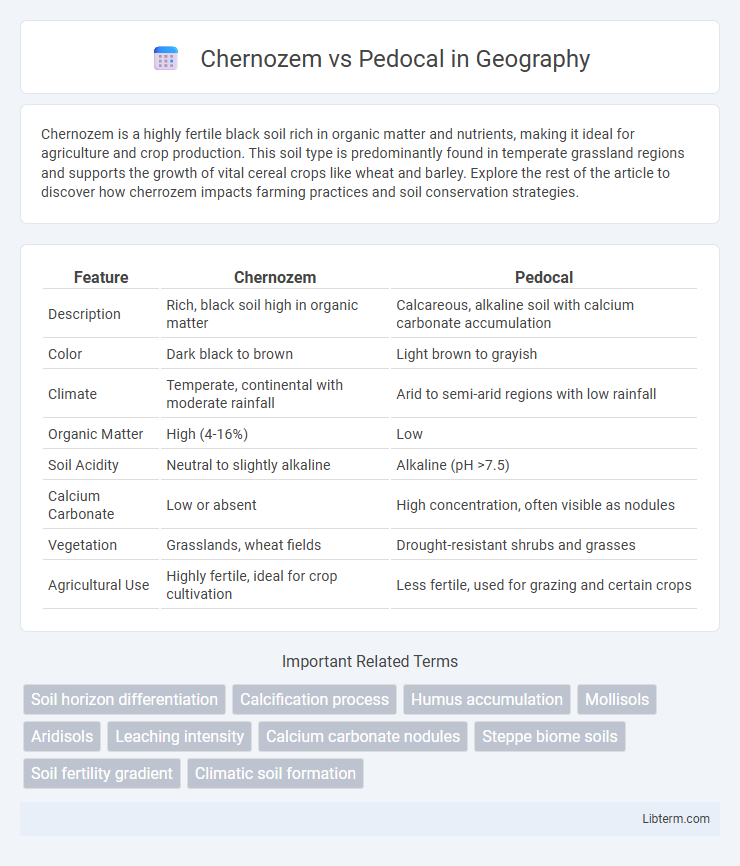Chernozem is a highly fertile black soil rich in organic matter and nutrients, making it ideal for agriculture and crop production. This soil type is predominantly found in temperate grassland regions and supports the growth of vital cereal crops like wheat and barley. Explore the rest of the article to discover how cherrozem impacts farming practices and soil conservation strategies.
Table of Comparison
| Feature | Chernozem | Pedocal |
|---|---|---|
| Description | Rich, black soil high in organic matter | Calcareous, alkaline soil with calcium carbonate accumulation |
| Color | Dark black to brown | Light brown to grayish |
| Climate | Temperate, continental with moderate rainfall | Arid to semi-arid regions with low rainfall |
| Organic Matter | High (4-16%) | Low |
| Soil Acidity | Neutral to slightly alkaline | Alkaline (pH >7.5) |
| Calcium Carbonate | Low or absent | High concentration, often visible as nodules |
| Vegetation | Grasslands, wheat fields | Drought-resistant shrubs and grasses |
| Agricultural Use | Highly fertile, ideal for crop cultivation | Less fertile, used for grazing and certain crops |
Introduction to Chernozem and Pedocal
Chernozem soils are rich, dark, and fertile, characterized by high organic matter content and abundant humus that supports intensive agriculture in temperate grassland regions. Pedocal soils contain calcium carbonate accumulation, are typically found in arid and semi-arid climates, and have less organic matter compared to Chernozem. The distinct mineral composition and moisture availability differentiate Chernozem's productivity from the more limited fertility of Pedocal soils.
Formation Processes of Chernozem
Chernozem forms primarily in temperate grassland regions through the accumulation of organic matter from dense root systems and slow decomposition due to moderate moisture levels. This soil type develops a thick, dark humus-rich A horizon resulting from the transformation of plant residues combined with calcium carbonate precipitation under well-drained conditions. In contrast, Pedocals form in semi-arid environments with limited organic accumulation and higher evaporation rates, leading to calcium carbonate accumulation closer to the surface.
Formation Processes of Pedocal
Pedocal soils form in arid and semi-arid regions where limited rainfall results in minimal leaching, causing calcium carbonate to accumulate in the soil profile. The accumulation of calcium carbonate, or caliche, creates a hardpan layer that influences soil fertility and water retention. In contrast, Chernozem soils develop under grasslands with higher organic matter input and more balanced moisture, leading to rich, dark-colored soils with deep humus layers.
Geographic Distribution
Chernozem soils predominantly occur in temperate grassland regions such as the Ukrainian steppes, the Canadian prairies, and parts of Russia, characterized by high organic matter and moisture levels. Pedocal soils are mainly found in arid and semi-arid areas like the southwestern United States and parts of Australia, where calcium carbonate accumulates due to limited rainfall. The geographic distribution of Chernozem aligns with humid continental climates, whereas Pedocal typically correlates with desert and shrubland biomes.
Physical and Chemical Properties
Chernozem soils exhibit high humus content, typically between 3-15%, contributing to dark color and excellent fertility with well-developed granular structure. Pedocal soils have lower organic matter, often less than 2%, with calcium carbonate accumulation causing lighter color and higher alkalinity. Chernozems possess neutral to slightly alkaline pH (6.5-7.5), whereas pedocals commonly display more alkaline conditions (pH 7.5-8.5) due to calcium carbonate presence.
Nutrient Content and Fertility
Chernozem soils are rich in organic matter, particularly humus, resulting in high nutrient content and exceptional fertility ideal for agriculture. Pedocal soils exhibit lower organic matter and nutrient levels due to limited decomposition processes and accumulation of calcium carbonate, leading to moderate fertility. The high nutrient density in Chernozem supports robust plant growth, while Pedocal requires supplementation for optimal crop yields.
Climate Influence on Soil Development
Chernozem soils develop predominantly in temperate grassland climates with moderate precipitation, promoting high organic matter accumulation and rich, dark topsoil. Pedocal soils form in arid to semi-arid regions where limited rainfall leads to calcium carbonate accumulation and lower organic content. Climate influences soil moisture regimes and vegetation types, directly affecting nutrient cycling and mineral deposition in these soil orders.
Agricultural Uses and Productivity
Chernozem soils, rich in organic matter and nutrients like humus, phosphorus, and potassium, offer high fertility ideal for cultivating cereals, vegetables, and several cash crops, promoting superior agricultural productivity. Pedocal soils contain more calcium carbonate, have lower organic content, and exhibit limited water retention, making them less fertile and more suitable for drought-resistant crops such as certain grains and xerophytic plants. Effective agricultural management in Chernozem regions leads to higher crop yields, while Pedocal areas often require soil amendments and irrigation to improve plant growth and productivity.
Environmental Impacts and Sustainability
Chernozem soils, characterized by high organic matter and nutrient content, promote sustainable agriculture by enhancing soil fertility and carbon sequestration, reducing the need for synthetic fertilizers and mitigating greenhouse gas emissions. Pedocal soils, with lower organic content and higher alkalinity, often require more intensive management and amendments to support crop growth, potentially leading to increased soil degradation, salinization, and reduced long-term sustainability. The environmental impact of Chernozem is generally positive due to its natural productivity and resilience, whereas Pedocal demands careful land use practices to prevent environmental harm and maintain ecosystem health.
Key Differences Between Chernozem and Pedocal
Chernozem is characterized by a thick, dark, organic-rich topsoil with high humus content and excellent fertility, primarily found in temperate grasslands. Pedocal soils have a lighter color, lower organic matter, and accumulate calcium carbonate due to arid or semi-arid conditions, leading to limited nutrient availability. The key differences are their organic content, climate of formation, and mineral composition, influencing their agricultural productivity and ecosystem support.
Chernozem Infographic

 libterm.com
libterm.com